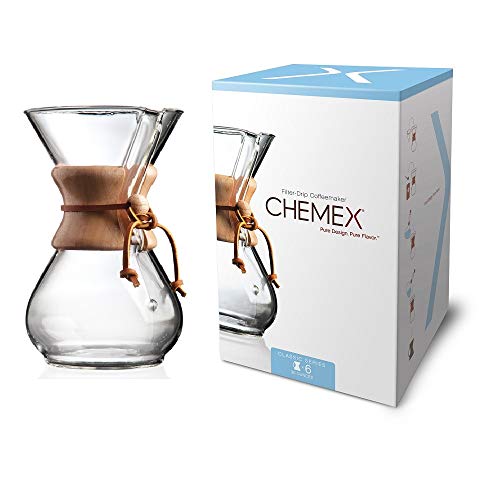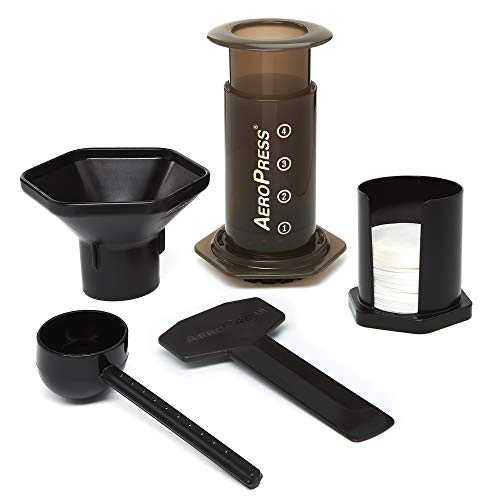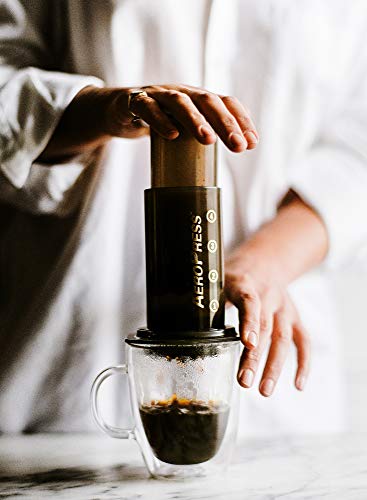Which of these impressive coffee makers should win a place in your home really depends on your lifestyle?
There are some awesome benefits to brewing coffee at home. It costs a lot less, you can do it in your pj’s, and there’s nearly no wait time. It’s perfect for when you roll out of bed in desperate need of a caffeine fix.
And if you’re doing your own brewing… we recommend going the whole way and ditching the machines in favor of manual brewing.
- Your coffee will taste better, because you’ll be able to use water that’s the perfect temperature, and brew the ideal amount of grounds for the optimum amount of time.
- Manual brewing is cheaper – both in terms of the contraptions used, and the grounds.
- It’s hip and it feels classy. It’s a skill that brings pleasure to both you and those around you.
In this article, we’re going to compare two of the most popular home brewing coffee makers: the Chemex and the Aeropress. You’ll get the answer to one of life’s burning questions (which one should you buy), and also tons of inspiration to fuel future brewing sessions.
Let’s get started.
3Chemex vs. Aeropress: There’s a Big Difference in Build
These coffee making contraptions were invented nearly a century apart, and not only look entirely different, but also brew using different techniques.
The Chemex is an Enduring Favorite from the World War II Era
 It was invented in the USA in 1941. It’s simply a glass, hourglass-shaped vessel with a heatproof wooden collar, held in place by a beaded strip of leather. It’s so gorgeous looking that there’s a Chemex currently on display in New York’s Museum of Modern Art.
It was invented in the USA in 1941. It’s simply a glass, hourglass-shaped vessel with a heatproof wooden collar, held in place by a beaded strip of leather. It’s so gorgeous looking that there’s a Chemex currently on display in New York’s Museum of Modern Art.
The Chemex uses a unique, wonderfully thick filter, which produces some distinctive, clean-tasting coffee. It’s especially apt for brewing coffee with delicate notes, because it brings these out instead of muddying them over with more powerful flavors. There’s less bitterness and acidity than you’ll find in most other brewing methods.
The Aeropress was Invented for a Modern, On-the-go Lifestyle
 Its birthplace was also the USA, but it was dreamed up in 2005. It’s made of highly food-safe polypropylene plastic, and is remarkably similar to a syringe: various plastic components (with a paper filter in there somewhere) fit together to form a long cylinder that can be pressed to render out the coffee.
Its birthplace was also the USA, but it was dreamed up in 2005. It’s made of highly food-safe polypropylene plastic, and is remarkably similar to a syringe: various plastic components (with a paper filter in there somewhere) fit together to form a long cylinder that can be pressed to render out the coffee.
The pressure used when finishing up the brew means that the resulting coffee offers a powerful, intense flavor. It makes a wonderful espresso knock-off. While it’s not unusually low in acidity, the taste is still pretty clean.
Chemex vs. Aeropress: The Method Determines the Flavor
Most of the differences between the Chemex and Aeropress boil down to a single factor: how the coffee is made.
There’s a bunch of different ways to coax that adored flavor out of coffee grounds. These include the percolating, drip, pour over, press, immersion, and vacuum methods. The Chemex and the Aeropress use different styles. Here’s a basic rundown of how coffee is made in each machine… and what that means.
Chemex Coffee is Made with Care
How to make coffee with a Chemex:
- Boil some water.
- Unfold the Chemex filter and slip it into the top of the Chemex, lining up the side of the filter that has three layers of paper with the vessel spout.
- Pour hot water on the filter to rinse out the papery taste, and discard the water.
- Measure ground coffee into the filter; gently tap or shake the paper to help the grounds to settle.
- Pour just enough water over the coffee grounds to wet them. Let the wet grounds rest for 45 seconds. This process is called “blooming” and prepares the grounds for use.
- Pour your hot water in circles on the grounds. Try to keep the water flowing for no longer than 2 minutes and 45 seconds, and to keep it away from the center and outermost edges of the grounds.
- Wait for all the water to drain from the filter. This should take less than a minute.
- Your coffee is ready to be poured and enjoyed.
This style of brewing is called “drip” and yields very specific results. There’s very little variety in the way the finished cup of coffee can taste and feel on the palate… but when it’s made in a Chemex, that flavor is pretty incredible. It’s creamy, rich, and clean.
Aeropress Coffee is a Quick Punch of Power
How to make coffee with an Aeropress:
- Boil some water.
- Assemble the Aeropress by placing a filter into the cap and fitting the parts together.
- Position the Aeropress over a mug or coffee beaker.
- Wet the filter with a little warm water.
- Add coffee.
- Add hot water.
- Stir for around 10 seconds.
- Pop in the plunger and press down until it hisses (around 20 seconds).
- Enjoy your cuppa!
There’s a lot of versatility when you’re using an Aeropress: you can fit a paper or a metal filter, use the “inverted method” (the steps outlined above are the “original method”), or employ tons of other variations: each one yielding a different flavor and texture combination. Plus, the “immersion” style of brewing, however brief, puts out a lot of power when it comes to taste.
Chemex vs. Aeropress: Reviewing All the Factors
So the Chemex and the Aeropress look different, and they make a pretty different cup of coffee. We’re going to pit them against each other, now: we’re going to compare their aesthetics, convenience, ease of use and ultimate flavor-creating capabilities… and see if we can crown a distinct winner.
Price
The Chemex will cost you $40 and up, with a box of a hundred filters checking out at around $12.
You can pick up an Aeropress for just over $30, with a packet of 350 filters costing around $8.
The Aeropress wins when it comes to both short term and long term charges.
Aesthetics
The Chemex is crafted from glass, leather and wood, and sports classy hourglass curves that compete with Ms. Monroe’s. The Aeropress is a plastic contraption that looks kind of like that overly-fussy thingamajig with an obscure application that Aunty Sue bought you three Christmases ago, and now hogs up the space at the back of a kitchen cabinet.
The Chemex holds a place in a famous art museum. It wins this round.
Convenience
There’s a lot to consider here. We’re going to analyze several aspects that contribute to the convenience of these coffee makers.
Hardiness
 The Chemex is crafted out of glass. The heat proof collar is loosely bound in place by a leather band. The Aeropress is made of plastic that we challenge the Hulk to destroy. I think I see a clear winner here.
The Chemex is crafted out of glass. The heat proof collar is loosely bound in place by a leather band. The Aeropress is made of plastic that we challenge the Hulk to destroy. I think I see a clear winner here.
This brings up one of the most significant differences between the Chemex and the Aeropress: the Aeropress is an excellent traveler, even a favorite coffee mate on camping sites. It comes in a neat little bag and can go with you… literally anywhere. The Chemex, on the other hand, is exclusively for using in your home because of its fragility. And if, like me, you’re the proud parent of a gang of toddlers… you’d better guard that thing with your life.
Brewing Time
It’s hard to judge which coffee maker can churn out the fastest cup of Joe, considering that there’s different ways to use both. However, assuming that you’re using the fastest methods available, the Aeropress takes around 3 minutes after pouring water over the grounds to produce a fragrant cup. The Chemex takes just over four minutes, including time for “blooming” the grounds. The Aeropress is faster by a small margin.
Easy Use
Expert baristas can turn the application of the Aeropress into an awe-inspiring art form, but if you want it to be, it’s a pretty gung-ho process. Assemble, add grounds and water, wait a couple minutes, squirt out coffee.
The Chemex, though, takes care, patience and deliberation. You pour. You wait, using a timer, or an inbuilt sense of time built up over months or years of experience. You pour again, delicately, and then you wait once more. Finally, you can serve your coffee, holding the hot glass via the single slim collar.
The use of the Chemex looks impressive. It’s wonderful for hosting, or as a comforting ritual when you’re enjoying down time. It works under an experienced hand, though, and probably shouldn’t be attempted when you’ve got a lot of other stuff happening.
Adding to the ease of use, when it comes to coffee makers, is their capacity. I like to make coffee for my guests in just one sitting. The Chemex comes in different sizes, the largest being the 1850ml model, which can brew up to thirteen cups. Again, this is ideal for hosting. The Aeropress, on the other hand, holds just a single cup of hot water. You can increase the portion of grounds and then water down the resulting brew… but, according to connoisseurs, the coffee made that way isn’t quite as exquisite.
Considering that you’ll probably be making coffee for one or two much more often than you’ll be making for a roomful of people, the Aeropress, the coffee god of the campsite, wins this round.
Cleanup
 Let’s get real for a moment: the Chemex is pretty tough to clean. To keep the glass looking pretty, it needs to be cleaned often, but it can’t go in the dishwasher because of the decorative wood and leather collar (unless you remove it). The neck of the hourglass is narrow, so it’s also hard to get your hand inside.
Let’s get real for a moment: the Chemex is pretty tough to clean. To keep the glass looking pretty, it needs to be cleaned often, but it can’t go in the dishwasher because of the decorative wood and leather collar (unless you remove it). The neck of the hourglass is narrow, so it’s also hard to get your hand inside.
For an everyday wash, you can swill hot, soapy water around the inside of the beaker, and use a long-handled brush to dislodge any stubborn sediment. For a deep clean, use vinegar.
The Aeropress, happily, couldn’t be easier to clean. The plunger helps to wipe the inside, so it generally just needs a rinse after use, but you can put it in the dishwasher for a thorough clean.
Flavor
Above, we mentioned that Chemex coffee is smooth and delicate, while Aeropress coffee is punchy. If I was assigning awards based on personal preference, I’d say the Chemex wins in the flavor department. I adore a rich, creamy coffee, lacking sharp, bitter acidity, and I like being able to taste all the nuances of that particular blend of grounds that I picked out.
However, considering this aspect with the bigger picture in mind, I’d have to say there are no winners here. Some people can’t get enough of sharp and punchy coffee. They don’t feel like they’ve woken up until a hot cuppa punches them in the gut. And the Aeropress really does make a good espresso knock-off.
Chemex vs Aeropress: The Winner
I know you’d like a clear cut answer. And which coffee maker would work best for you actually is quite straightforward… depending on your lifestyle and how you like your coffee.
You’ll like the Chemex if:
- You tend to get pleasure out of methods that require a particular approach.
- You enjoy small rituals.
- You mostly make coffee at home and wouldn’t want to transport your coffee maker.
- You love tasting the many nuances of your beans.
- You love a rich and creamy cup that’s low on acidity.
- You host often.
You’ll like the Aeropress if:
- You love camping.
- You have a busy lifestyle and want to take your coffee maker with you when you travel.
- You don’t want your daily tasks to take up more time and attention than necessary.
- You love powerful, punchy coffee.
- You generally won’t be making a lot of cups at a time.












nice
thanks and cheers